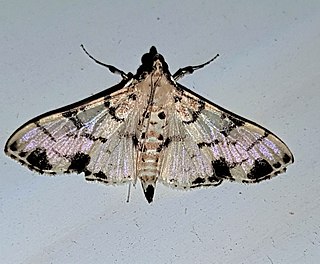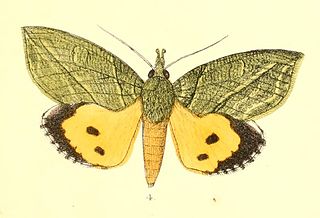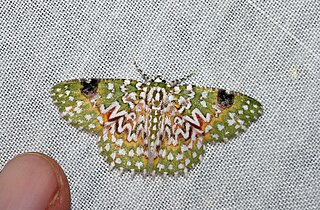
Daphnis nerii, the oleander hawk-moth or army green moth, is a moth of the family Sphingidae. It was described by Carl Linnaeus in his 1758 10th edition of Systema Naturae.

Azochis is a genus of moths of the family Crambidae. The genus was erected by Francis Walker in 1859.

Eudocima materna, the dot-underwing moth, is a moth of the family Erebidae found in widespread parts of the world, mainly in tropical Asia extending to New Guinea and Australia as well as in Africa. Reports from the United States, Canada and the French Antilles are now considered to be Eudocima apta. The species can be differentiated from other Eudocima moths by the presence of small central black dot in each hindwing. The species was first described by Carl Linnaeus in his 1767 12th edition of Systema Naturae.

Eudocima aurantia, the fruit-sucking moth, is a moth of the family Erebidae. The species was first described by Frederic Moore in 1877. It is found across south-east Asia, from Sri-Lanka to northern Queensland, Australia. It is also present on the Andamans.

Eudocima hypermnestra is a moth of the family Erebidae described by Pieter Cramer in 1780. It is found in China, Thailand, Taiwan, India and Sri Lanka.

Berta chrysolineata is a species of moth of the family Geometridae described by Francis Walker in 1863. It is widespread from the Indo-Australian tropics of India, Sri Lanka to the Solomons.

Eucyclodes gavissima, the Oriental orange banded green geometer moth, is a species of moth of the family Geometridae described by Francis Walker in 1861. It is found in the Indian subregion, Sri Lanka, Bhutan, western China, Taiwan, Vietnam, Sumatra and Borneo.
Scopula pedilata is a moth of the family Geometridae. It is found in Sri Lanka.
Axinoptera subcostalis is a moth in the family Geometridae. It was first described by George Hampson in 1893 and is found in Sri Lanka.
Gymnoscelis deleta is a moth in the family Geometridae. It is found in India, Korea, Japan, Taiwan and probably in Sri Lanka according to Hampson.
Gymnoscelis ectochloros is a moth in the family Geometridae. It was described by George Hampson in 1891. It is found in India and Sri Lanka according to Hampson.
Pomasia psylaria is a moth in the family Geometridae. It is found in Sri Lanka.

Risoba repugnans is a species of moth of the family Nolidae first described by Francis Walker in 1865.
Prionapteryx albicostalis is a moth in the family Crambidae. It was described by George Hampson in 1919. It is found in what was Madras State in India.
Surattha diffusilinea is a moth in the family Crambidae. It was described by George Hampson in 1919. It is found in Australia, where it has been recorded from New South Wales.
Conchylodes bryophilalis is a moth in the family Crambidae. It was described by George Hampson in 1899. It is found in Ecuador.
Desmia microstictalis is a moth in the family Crambidae. It was described by George Hampson in 1904. It is found in the Bahamas.
Syllepte chalybifascia is a moth in the family Crambidae. It was described by George Hampson in 1896. It is found in India (Nagas).
Talanga talangalis is a moth in the family Crambidae. It was described by George Hampson in 1899. It is found in the Loyalty Islands in the Pacific Ocean east of Australia.

Sphingomorpha chlorea, the sundowner moth, is a species of moth in the family Erebidae that is native to Africa and southern Asia. The species was first described by Pieter Cramer in 1777. It is a fruit-piercing moth and a notorious pest in orchards. The fruit is pierced while performing a vertical and rhythmic movement of the head.








